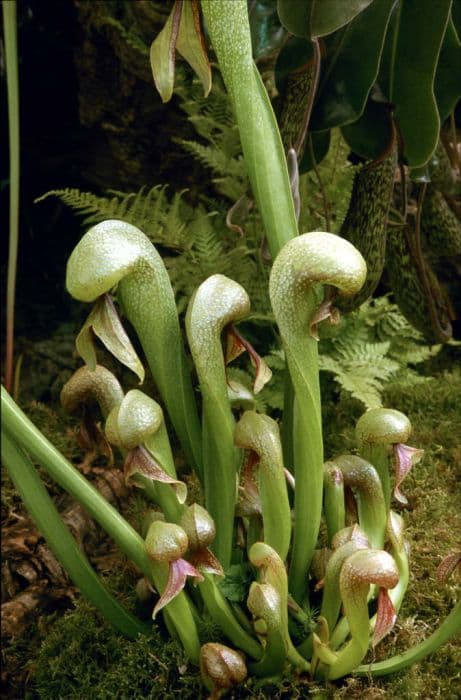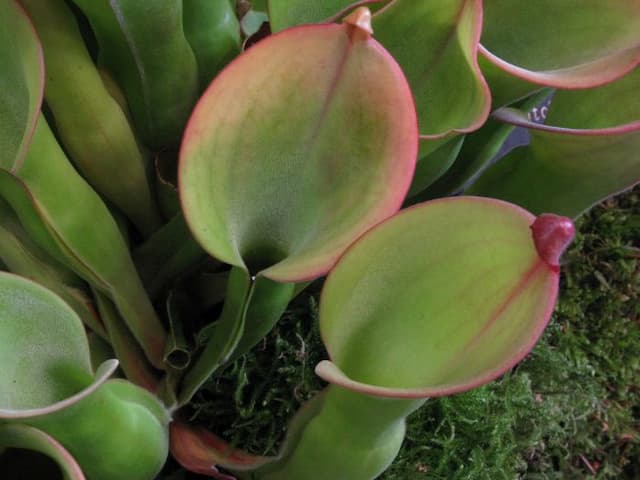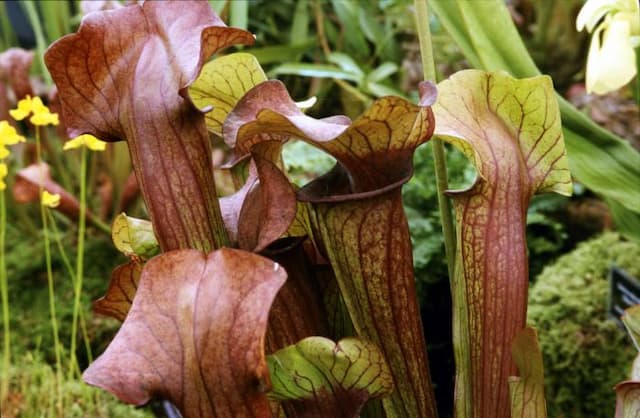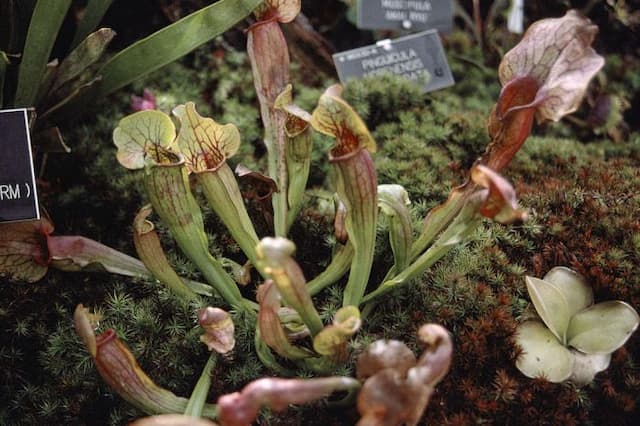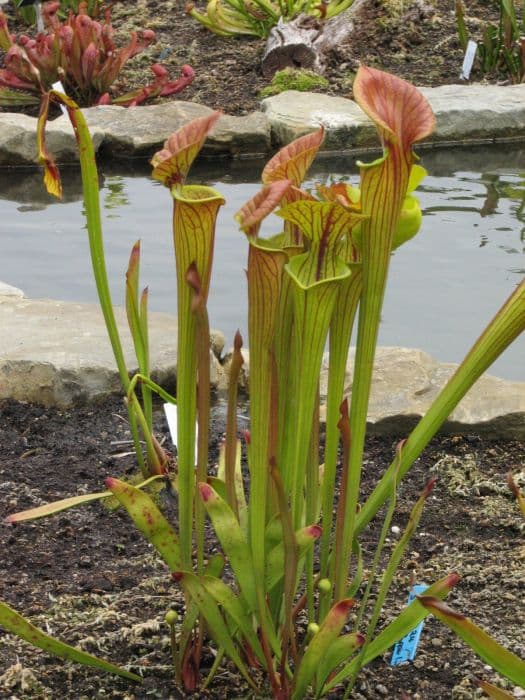Pitcher plant Sarracenia 'Jenny Helen'
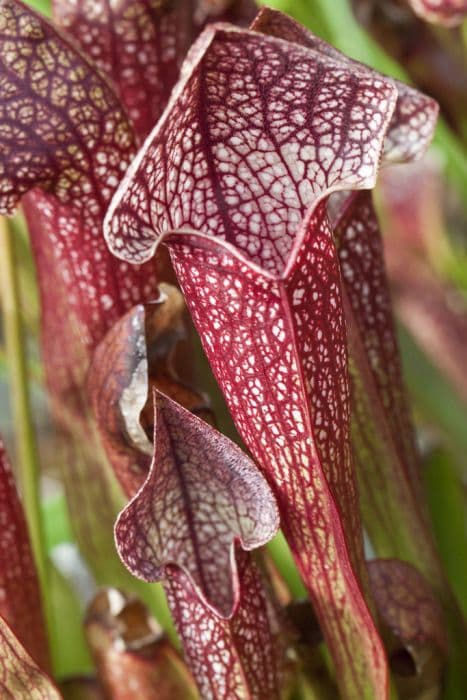
ABOUT
Sarracenia 'Jenny Helen' is a cultivar of pitcher plant known for its unique and captivating appearance, characterized by tube-shaped leaves that stand upright, resembling slender pitchers. The leaves are designed to attract and trap insects, contributing to the plant's unique predatory nature. They boast vibrant colors which tend to be a mix of green, red, and purple hues, oftentimes with attractive veining or speckling patterns that add to their visual interest. Each 'pitcher' is a hollow structure sealed at the end, with an open top that is often flared into a lid or hood, which offers a landing spot for unsuspecting insects. The hood protects the opening from rainwater, preventing it from diluting the digestive fluids inside the pitcher. Within the pitcher, there are downward-pointing hairs and a smooth, waxy surface that makes it difficult for trapped insects to climb out. Flowers emerge in the growing season on tall stalks that rise above the pitchers, sporting an umbrella-like appearance with a round shape. The petals may display gorgeous coloration that can draw the eye, adding an extra layer of aesthetic appeal to the plant. The distinctive form and brilliant color of Sarracenia 'Jenny Helen' make it an intriguing and ornamental addition to any garden, particularly those designed for carnivorous plants.
About this plant
 Names
NamesSynonyms
Jenny Helen Pitcher Plant, Hybrid Pitcher Plant
Common names
Sarracenia 'Jenny Helen'
 Toxicity
ToxicityTo humans
The Sarracenia 'Jenny Helen', commonly referred to as the pitcher plant, is not widely recognized as toxic to humans. However, as with any plant, individuals may have unique sensitivities or allergic reactions to the plant or its sap. It is generally advisable not to ingest parts of ornamental plants due to potential unknown toxicities or adverse reactions. If you suspect someone has ingested part of a pitcher plant and is experiencing adverse effects, seek medical advice.
To pets
The pitcher plant is not typically known for being toxic to pets. However, individual animals can have different reactions to ingesting plants, and the pitcher plant could potentially cause gastrointestinal upset or other issues. Keep an eye on your pet for any signs of distress if ingestion occurs, and consult with your veterinarian if any concerns arise. Signs of plant poisoning in pets often include vomiting, diarrhea, lethargy, or changes in behavior.
 Characteristics
CharacteristicsLife cycle
Perennials
Foliage type
Deciduous
Color of leaves
Varies
Flower color
Yellow
Height
1-3 feet (30-91 cm)
Spread
1-2 feet (30-61 cm)
Plant type
Herb
Hardiness zones
5
Native area
North America
Benefits
 General Benefits
General Benefits- Educational Interest: Sarracenia 'Jenny Helen', commonly known as a type of Pitcher Plant, can provide educational opportunities for learning about carnivorous plants and their adaptations for survival.
- Ecosystem Support: As a carnivorous plant, it may contribute to controlling the populations of insects within an ecosystem, promoting a balance.
- Garden Aesthetics: Its unique pitcher-like structures and vivid colors can add visual interest and variety to a garden collection.
- Horticultural Enthusiasm: The care and cultivation of Pitcher Plants like Sarracenia 'Jenny Helen' can be a rewarding hobby for plant enthusiasts.
- Conservation Value: Growing Pitcher Plants can increase awareness and support the conservation of bog habitats and other ecosystems where these plants naturally occur.
- Wildlife Attraction: The plant can attract and provide a food source for certain insects and possibly even small amphibians or reptiles which in turn can attract a variety of birds and other wildlife.
 Medical Properties
Medical PropertiesThis plant is not used for medical purposes.
 Air-purifying Qualities
Air-purifying QualitiesThis plant is not specifically known for air purifying qualities.
 Other Uses
Other Uses- Photographic subjects: Sarracenia 'Jenny Helen', commonly known as the North American pitcher plant, can be used by photographers and artists for macro photography due to its unique and intricate structure.
- School science projects: The pitcher plant's method of trapping insects can be a fascinating subject for students learning about carnivorous plants and their adaptations.
- Insect management: These plants can be used in gardens to naturally reduce the number of pests without the need for chemical insecticides.
- Decorative displays: Their exotic appearance makes North American pitcher plants suitable for inclusion in floral arrangements and decorative terrariums.
- Biological studies: Scientists may use the pitcher plant for studying co-evolution, as some insects have adapted to escape the traps set by these carnivorous plants.
- Eco-tourism: Gardens and conservatories that feature pitcher plants may attract visitors interested in seeing these unusual plants in person.
- Nature-inspired design: The mechanism and physical structure of the North American pitcher plant can inspire biomimicry in architectural and industrial designs.
- Feeding terrarium animals: Some terrarium-dwelling creatures may benefit from the insects caught by pitcher plants when kept in a shared environment.
- Crafts and modeling: The unique shape of the pitcher plant pitchers can be mimicked or incorporated into various arts and crafts projects for aesthetic purposes.
- Botanical art: Plant enthusiasts and botanical artists often use pitcher plants as a subject for drawings, paintings, and sculpture, attracted by their vivid colors and complex shapes.
Interesting Facts
 Feng Shui
Feng ShuiThe Pitcher plant is not used in Feng Shui practice.
 Zodiac Sign Compitability
Zodiac Sign CompitabilityThe Pitcher plant is not used in astrology practice.
 Plant Symbolism
Plant Symbolism- Uniqueness: The Sarracenia 'Jenny Helen', commonly known as the Pitcher Plant, has a distinctive carnivorous nature, indicating a symbolism of uniqueness and individuality.
- Adaptation: Pitcher Plants have adapted to nutrient-poor environments by digesting insects, symbolizing the ability to thrive in challenging conditions.
- Attraction and Deception: The plant lures insects with nectar, only to trap and consume them, representing attraction with underlying deception.
- Balance in Nature: As a carnivorous plant, it plays a role in controlling insect populations, signifying balance and the interconnectedness of nature.
 Water
WaterThe Pitcher Plant requires regular watering to ensure the soil remains consistently moist but not waterlogged. During the growing season, typically from spring to fall, water thoroughly so that the potting mix is wet, adding about 1-2 gallons per week depending on weather conditions. In winter, reduce watering to maintain slight moisture, about half a gallon per week, as the plant enters dormancy. Always use distilled or rainwater, avoiding tap water which can contain minerals that may harm the plant. Never allow the Pitcher Plant to dry out completely.
 Light
LightPitcher Plants thrive in full sunlight, requiring a minimum of 6 hours of direct sun each day for optimal growth. The best spot for a Pitcher Plant would be outdoors in a sunny bog garden or on a windowsill where bright, direct light is guaranteed, especially during the growing season. Avoid placing them in deep shade as this can lead to weak growth and fewer pitchers.
 Temperature
TemperaturePitcher Plants favor warm temperatures during the growing season, with ideal conditions between 70°F and 90°F. While they can withstand temperatures as low as 32°F for short periods, consistently cold weather below 40°F can damage or kill the plant. They also go through a winter dormancy period where they can survive cooler temperatures, which aids in their growth cycle.
 Pruning
PruningPrune Pitcher Plants by removing dead or brown pitchers and foliage to encourage new growth and maintain plant health; this is best done in early spring before new growth starts. Typically, pruning should be done once a year, but if pitchers die back during the growing season, they can be removed as needed. Use sterilized scissors or pruning shears to avoid introducing disease to the cut areas.
 Cleaning
CleaningAs needed
 Soil
SoilThe best soil mix for the North American Pitcher Plant (Sarracenia 'Jenny Helen') should be acidic and low in nutrients, ideally comprised of 50% sphagnum peat moss and 50% perlite or silica sand. The soil pH should be between 4.0 and 6.0.
 Repotting
RepottingNorth American Pitcher Plant should be repotted every 2-3 years to refresh the soil and accommodate growth; do this in late winter or early spring before new growth begins.
 Humidity & Misting
Humidity & MistingThe North American Pitcher Plant thrives in high humidity, preferably around 60-80%, to support its pitcher formation and overall health.
 Suitable locations
Suitable locationsIndoor
Provide bright light, high humidity, and cool temperatures.
Outdoor
Full sun, keep moist, protect from frost.
Hardiness zone
6-9 USDA
 Life cycle
Life cycleThe Trumpet Pitcher 'Jenny Helen' starts its life cycle as a seed, which requires stratification—a period of cold dormancy—to germinate. Once the seed germinates, a small rosette of juvenile pitcher leaves emerges and the plant enters a vegetative growth phase where it focuses on photosynthesis and nutrient acquisition, often from trapped insects. As the plant matures, it develops elongated, tube-shaped adult pitchers with intricate colors and patterns, which are adaptations for attracting and digesting prey. Throughout the growing season, 'Jenny Helen' may produce flowers on tall stalks that, when pollinated, will set seed for the next generation. During the dormancy period, typically in the winter, the above-ground foliage dies back and the plant conserves energy in its rhizome underground. With the return of favorable conditions in spring, the plant resumes growth, repeating its life cycle.
 Propogation
PropogationPropogation time
Spring-Early Summer
Propogation: For the pitcher plant named Sarracenia 'Jenny Helen', the most popular method of propagation is through division, which is typically done in the early spring before the growing season commences. This process involves carefully separating the rhizome, which is the underground part of the stem, into smaller sections making sure that each division has at least one growth point or bud. Using a sharp, sterile knife helps prevent infection and damage to the plant. The sections are then potted individually in a suitable growing medium that is moist and well-draining. It is essential to keep the newly potted divisions warm and humid as they establish roots and new growth, ensuring a successful propagation.
